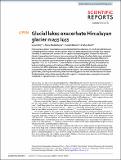Glacial lakes exacerbate Himalayan glacier mass loss
Date
02/12/2019Metadata
Show full item recordAbstract
Heterogeneous glacier mass loss has occurred across High Mountain Asia on a multi-decadal timescale. Contrasting climatic settings influence glacier behaviour at the regional scale, but high intra-regional variability in mass loss rates points to factors capable of amplifying glacier recession in addition to climatic change along the Himalaya. Here we examine the influence of surface debris cover and glacial lakes on glacier mass loss across the Himalaya since the 1970s. We find no substantial difference in the mass loss of debris-covered and clean-ice glaciers over our study period, but substantially more negative (-0.13 to -0.29 m w.e.a-1) mass balances for lake-terminating glaciers, in comparison to land-terminating glaciers, with the largest differences occurring after 2000. Despite representing a minor portion of the total glacier population (~10 %), the recession of lake-terminating glaciers accounted for up to 32 % of mass loss in different sub-regions. The continued expansion of established glacial lakes, and the preconditioning of land-terminating glaciers for new lake development increases the likelihood of enhanced ice mass loss from the region in coming decades; a scenario not currently considered in regional ice mass loss projections.
Citation
King , O , Bhattacharya , A , Bhambri , R & Bolch , T 2019 , ' Glacial lakes exacerbate Himalayan glacier mass loss ' , Scientific Reports , vol. 9 , 18145 . https://doi.org/10.1038/s41598-019-53733-x
Publication
Scientific Reports
Status
Peer reviewed
ISSN
2045-2322Type
Journal article
Description
This study was supported by the Swiss National Science Foundation (Grant No. IZLCZ2_169979/1) the Dragon 4 project funded by ESA (4000121469/17/I-NB) and the Strategic Priority Research Program of Chinese Academy of Sciences (XDA20100300).Collections
Items in the St Andrews Research Repository are protected by copyright, with all rights reserved, unless otherwise indicated.

